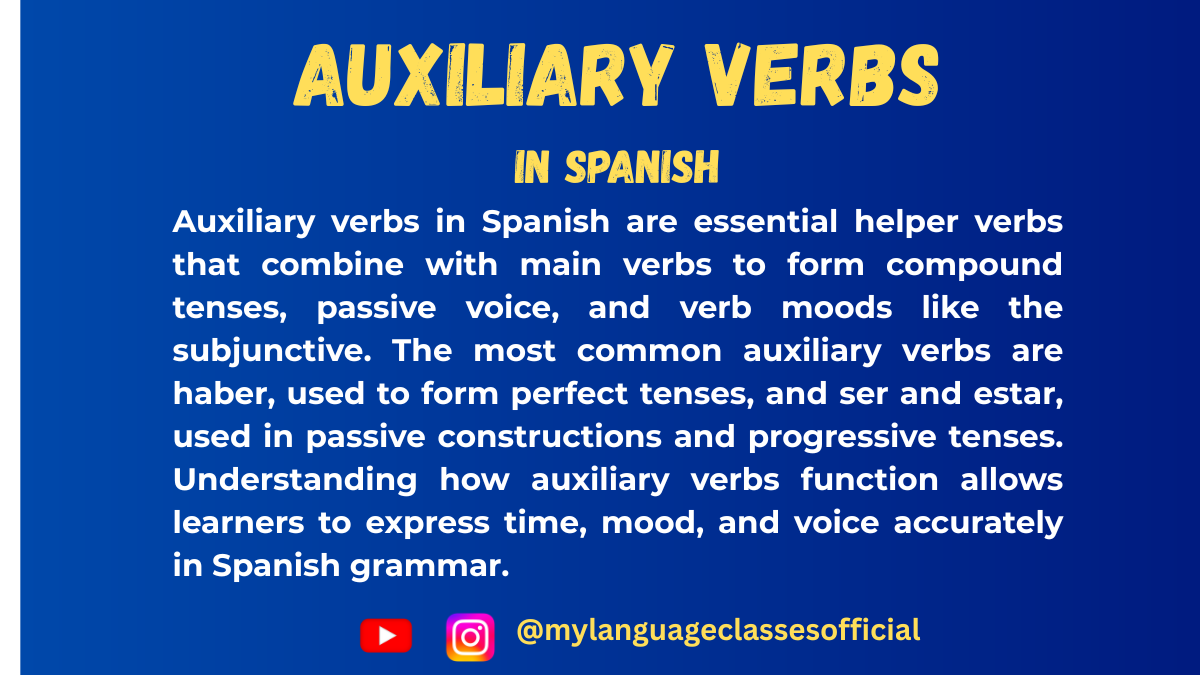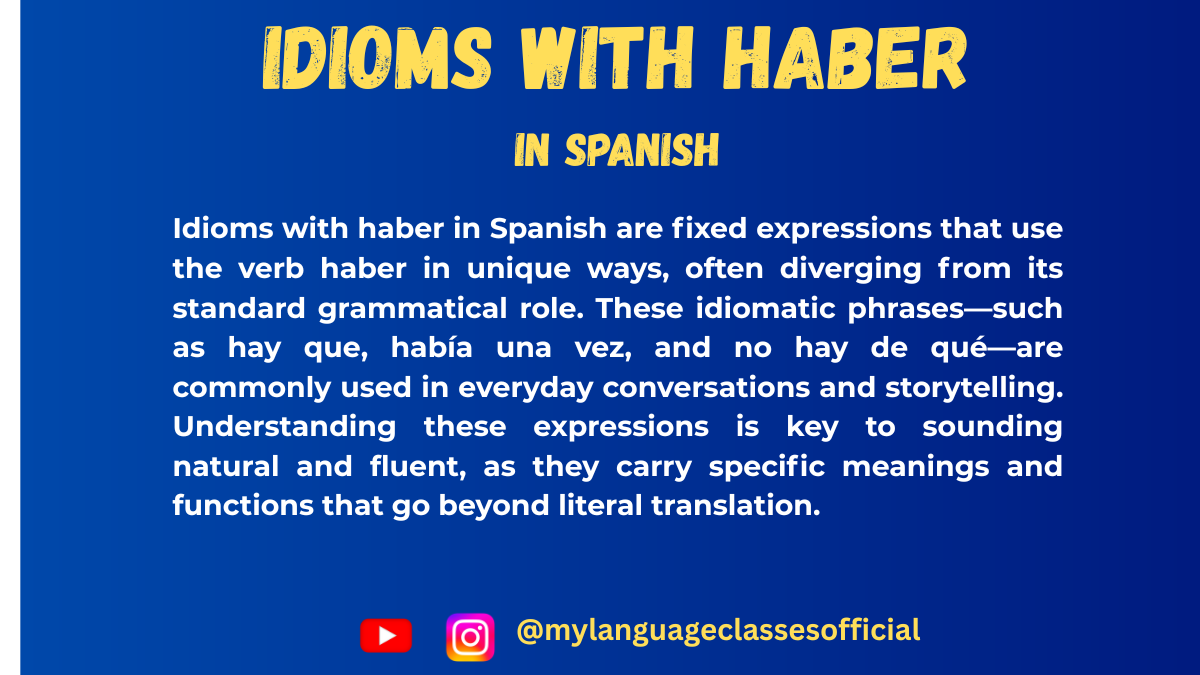Your cart is currently empty!
Tag: how to use haber in Spanish
-

Auxiliary Verbs in Spanish: A Complete Guide
Auxiliary verbs, or “verbos auxiliares” in Spanish, play a crucial role in forming various tenses, moods, and grammatical structures. They are used in conjunction with main verbs to express nuances such as obligation, ability, probability, or temporality. Understanding auxiliary verbs is essential for mastering Spanish fluency.
Common Auxiliary Verbs in Spanish
- Haber (to have – for perfect tenses)
- Ser (to be – for passive voice and descriptions)
- Estar (to be – for progressive tenses and states)
- Tener que (to have to – for obligations)
- Deber (must/should – for necessity and advice)
- Poder (can – for ability and permission)
- Ir a (going to – for future actions)
- Querer (to want – for desires and intentions)
- Soler (to usually – for habitual actions)
1. Haber: Forming Perfect Tenses
Haber is used as an auxiliary verb to form compound tenses like the present perfect, past perfect, and future perfect.
Conjugation of Haber (Present Indicative):
- Yo he
- Tú has
- Él/Ella/Usted ha
- Nosotros/as hemos
- Vosotros/as habéis
- Ellos/Ellas/Ustedes han
Example Sentences:
- Yo he comido hoy. (I have eaten today.)
- ¿Has visto la película? (Have you seen the movie?)
Things to Keep in Mind:
- The past participle always remains unchanged (e.g., comido, visto, escrito).
- Haber must be conjugated in the correct tense and subject agreement.
2. Ser and Estar: Expressing Passive Voice and Progressive Tenses
- Ser is used for the passive voice and permanent characteristics.
- Estar is used for the present progressive tense and temporary conditions.
Conjugation of Ser (Present Indicative):
- Yo soy
- Tú eres
- Él/Ella/Usted es
- Nosotros/as somos
- Vosotros/as sois
- Ellos/Ellas/Ustedes son
Conjugation of Estar (Present Indicative):
- Yo estoy
- Tú estás
- Él/Ella/Usted está
- Nosotros/as estamos
- Vosotros/as estáis
- Ellos/Ellas/Ustedes están
Example Sentences:
- La puerta es cerrada por el profesor. (The door is closed by the teacher.)
- Estoy estudiando español. (I am studying Spanish.)
3. Tener que, Deber, and Poder: Expressing Obligation, Necessity, and Ability
- Tener que + infinitive: Expresses strong obligation.
- Ejemplo: Tengo que trabajar mañana. (I have to work tomorrow.)
- Deber + infinitive: Expresses necessity or recommendation.
- Ejemplo: Debes hacer ejercicio. (You should exercise.)
- Poder + infinitive: Expresses ability or permission.
- Ejemplo: ¿Puedes ayudarme? (Can you help me?)
4. Ir a + Infinitive: Talking About the Near Future
This structure is similar to the English “going to.” It is commonly used in spoken Spanish.
Example Sentences:
- Voy a viajar a España. (I am going to travel to Spain.)
- ¿Vas a llamar a tu madre? (Are you going to call your mother?)
5. Querer and Soler: Expressing Intentions and Habits
- Querer + infinitive: Expresses desire.
- Ejemplo: Quiero aprender español. (I want to learn Spanish.)
- Soler + infinitive: Expresses habitual actions.
- Ejemplo: Suelo leer antes de dormir. (I usually read before sleeping.)
Conjugation of Regular and Irregular Verbs in Auxiliary Verb Constructions
Spanish verbs fall into three categories: -AR, -ER, and -IR verbs.
Regular Verb Conjugation in the Present Participle (Gerundio)
- -AR verbs: hablar → hablando (speaking)
- -ER verbs: comer → comiendo (eating)
- -IR verbs: vivir → viviendo (living)
Past Participle Formation (Used with Haber)
- -AR verbs: hablar → hablado
- -ER verbs: comer → comido
- -IR verbs: vivir → vivido
Irregular Past Participles
- Decir → dicho (said)
- Hacer → hecho (done)
- Ver → visto (seen)
- Escribir → escrito (written)
List of Common Expressions with Auxiliary Verbs
Here are some daily expressions using auxiliary verbs:
- ¿Has comido? (Have you eaten?)
- Voy a salir ahora. (I am going to leave now.)
- Puedes ayudarme, por favor. (Can you help me, please?)
- Debemos estudiar más. (We must study more.)
- Tienes que llamar a tu madre. (You have to call your mother.)
Things to Keep in Mind
- Gender and Plurality: Auxiliary verbs themselves do not change for gender, but past participles used with “ser” must agree in gender and number (e.g., “La tarea fue hecha.”)
- Use of Articles: In general, articles (el, la, los, las) are necessary with nouns but not with infinitive verbs.
- Reflexive Verbs: When using auxiliary verbs with reflexive verbs, place the reflexive pronoun before the auxiliary verb or attach it to the infinitive (e.g., “Me voy a duchar” / “Voy a ducharme”).
Final Thoughts
Mastering auxiliary verbs in Spanish is essential for building more complex sentences and improving fluency. Understanding when and how to use “haber,” “ser,” “estar,” “tener que,” and other auxiliary verbs will help you navigate Spanish conversations with ease. Keep practicing with real-life examples, and soon, using these verbs will become second nature!
¿Quieres seguir aprendiendo? (Do you want to keep learning?) Stay tuned for more Spanish lessons!
If you enjoyed this lesson, be sure to check out more posts like this on my blog at My Language Classes. Don’t forget to subscribe my YouTube channel and follow me on Instagram for the latest language learning tips and lessons. Leave a comment below to share your thoughts, or ask any questions you have.
Happy learning! 😊
-

Present Perfect Tense (Pretérito Perfecto de Indicativo) in Spanish
The Pretérito Perfecto de Indicativo is a crucial tense in Spanish, used to describe actions or events that are connected to the present or have relevance to it. In English, it corresponds to the Present Perfect tense (e.g., “I have eaten”).
What is the Pretérito Perfecto de Indicativo?
The Pretérito Perfecto is used to describe:
- Actions that happened in the recent past and are relevant now.
- Hoy he estudiado mucho.
(Today I have studied a lot.)
- Hoy he estudiado mucho.
- Experiences or actions that have occurred at some point in life without specifying when.
- ¿Alguna vez has viajado a España?
(Have you ever traveled to Spain?)
- ¿Alguna vez has viajado a España?
- Actions within a time frame that has not yet ended (this week, this month, etc.).
- Esta semana hemos ido al cine dos veces.
(This week we have gone to the movies twice.)
- Esta semana hemos ido al cine dos veces.
- Unfinished past actions or those seen as having ongoing effects in the present.
- He vivido en Madrid durante tres años.
(I have lived in Madrid for three years.)
- He vivido en Madrid durante tres años.
How to Form the Pretérito Perfecto de Indicativo
This tense is formed with the present tense of the auxiliary verb “haber” + the past participle of the main verb.
1. Conjugation of “Haber” (to have)
This verb acts as an auxiliary verb in this tense. Below is its conjugation:
Subject Conjugation of Haber Yo he Tú has Él/Ella/Usted ha Nosotros/as hemos Vosotros/as habéis Ellos/Ellas/Ustedes han 2. Formation of the Past Participle
To form the past participle:
- For -AR verbs: Replace -ar with -ado.
- Hablar → Hablado (spoken)
- For -ER/-IR verbs: Replace -er/-ir with -ido.
- Comer → Comido (eaten)
- Vivir → Vivido (lived)
Irregular Past Participles:
Many verbs have irregular past participles. Here are some common ones:
Verb Past Participle English Abrir Abierto Opened Decir Dicho Said Escribir Escrito Written Hacer Hecho Done/Made Ver Visto Seen Volver Vuelto Returned Poner Puesto Put Romper Roto Broken
Common Expressions Using the Pretérito Perfecto
These phrases are frequently used with the Pretérito Perfecto to provide a context for the action:
- Hoy – Today
- Hoy he terminado el informe.
(Today I have finished the report.)
- Hoy he terminado el informe.
- Esta semana – This week
- Esta semana hemos tenido muchas reuniones.
(This week we have had many meetings.)
- Esta semana hemos tenido muchas reuniones.
- Alguna vez – Ever
- ¿Alguna vez has probado el sushi?
(Have you ever tried sushi?)
- ¿Alguna vez has probado el sushi?
- Nunca – Never
- Nunca he estado en Italia.
(I have never been to Italy.)
- Nunca he estado en Italia.
- Ya – Already
- Ya hemos hecho la tarea.
(We have already done the homework.)
- Ya hemos hecho la tarea.
- Todavía no – Not yet
- Todavía no han llegado.
(They have not arrived yet.)
- Todavía no han llegado.
- Recientemente – Recently
- Recientemente he leído un libro interesante.
(I have recently read an interesting book.)
- Recientemente he leído un libro interesante.
Key Grammar Rules and Considerations
- Gender and Number Agreement
The past participle does not change to agree with the subject because it is part of a compound tense.- Ellos han comido.
(They have eaten.) - Ella ha comido.
(She has eaten.)
- Ellos han comido.
- Object Pronouns
Object pronouns are placed before “haber.”- Me he levantado temprano.
(I have gotten up early.) - Nos hemos perdido en la ciudad.
(We have gotten lost in the city.)
- Me he levantado temprano.
- Negative Sentences
Place “no” before “haber.”- No he terminado el proyecto.
(I have not finished the project.)
- No he terminado el proyecto.
Conjugation Examples for Regular Verbs
1. -AR Verbs: Hablar (to speak)
Subject Conjugation Example Sentence Yo he hablado He hablado con mi amigo. Tú has hablado ¿Has hablado con ella? Él/Ella/Usted ha hablado Ha hablado mucho hoy. Nosotros/as hemos hablado Hemos hablado del problema. Vosotros/as habéis hablado Habéis hablado demasiado. Ellos/Ellas/Uds. han hablado Han hablado con el profesor. 2. -ER Verbs: Comer (to eat)
Subject Conjugation Example Sentence Yo he comido He comido pasta hoy. Tú has comido ¿Has comido algo? Él/Ella/Usted ha comido Ha comido en el restaurante. Nosotros/as hemos comido Hemos comido juntos. Vosotros/as habéis comido Habéis comido temprano. Ellos/Ellas/Uds. han comido Han comido mucho. 3. -IR Verbs: Vivir (to live)
Subject Conjugation Example Sentence Yo he vivido He vivido en Barcelona. Tú has vivido ¿Has vivido aquí mucho tiempo? Él/Ella/Usted ha vivido Ha vivido en muchas ciudades. Nosotros/as hemos vivido Hemos vivido cerca del mar. Vosotros/as habéis vivido Habéis vivido en España. Ellos/Ellas/Uds. han vivido Han vivido experiencias únicas.
Practice Exercises
- Conjugate these verbs in Pretérito Perfecto:
- Escribir
- Leer
- Decidir
- Volver
- Translate the following sentences into Spanish:
- I have never traveled to Mexico.
- They have opened the door.
- Have you seen the movie?
Conclusion
The Pretérito Perfecto de Indicativo is an indispensable tense for discussing past actions with present relevance. With consistent practice and attention to detail, you’ll be able to master its formation and usage effortlessly. ¡Buena suerte!
If you enjoyed this lesson, be sure to check out more posts like this on my blog at My Language Classes. Don’t forget to subscribe my YouTube channel and follow me on Instagram for the latest language learning tips and lessons. Leave a comment below to share your thoughts, or ask any questions you have.
- Actions that happened in the recent past and are relevant now.

